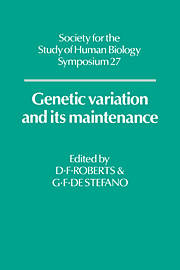Book contents
- Frontmatter
- Contents
- Preface
- Part I Genetic Diversity - Its Dimensions
- Part II Genetic Diversity - Its Origin and Maintenance
- Human genetic diversity in south-east Asia and the western Pacific
- Malaria-protective alleles in southern Africa: relict alleles of no health significance
- The genetic origin of the variability of the phenotypic expression of the Hb S gene
- Origin and maintenance of genetic variation in Black Carib populations of St. Vincent and Central America
- Historical and demographic factors and the genetic structure of an Afro-American Community of Nicaragua
- Migration and genetic polymorphisms in some Congo peoples
- Population structure studies and genetic variability in humans
- Inbreeding and the incidence of recessive disorders in the populations of Karnataka, South India
- Genetic diversity at the albumin locus
- GENETIC DIVERSITY - APPLICATIONS AND PROBLEMS OF COMPLEX CHARACTERS
- Index
The genetic origin of the variability of the phenotypic expression of the Hb S gene
Published online by Cambridge University Press: 05 March 2012
- Frontmatter
- Contents
- Preface
- Part I Genetic Diversity - Its Dimensions
- Part II Genetic Diversity - Its Origin and Maintenance
- Human genetic diversity in south-east Asia and the western Pacific
- Malaria-protective alleles in southern Africa: relict alleles of no health significance
- The genetic origin of the variability of the phenotypic expression of the Hb S gene
- Origin and maintenance of genetic variation in Black Carib populations of St. Vincent and Central America
- Historical and demographic factors and the genetic structure of an Afro-American Community of Nicaragua
- Migration and genetic polymorphisms in some Congo peoples
- Population structure studies and genetic variability in humans
- Inbreeding and the incidence of recessive disorders in the populations of Karnataka, South India
- Genetic diversity at the albumin locus
- GENETIC DIVERSITY - APPLICATIONS AND PROBLEMS OF COMPLEX CHARACTERS
- Index
Summary
INTRODUCTION
All individuals with sickle cell anemia have two β genes that encode a valine residue instead of a glutamic residue in position 6 (Bookchin & Nagel, 1981). Nevertheless the clinical or phenotypic expression of this homozygous genetic abnormality is extremely variable from individual to individual (Labie, 1983; Nagel & Fabry, 1986). Although environmental factors are obviously involved they do not account for most of the variability, and other genetic factors have to be invoked. In the last few years significant progress has been made in this area and the findings from our laboratories and those of others indicate three genetic sources for the variability in the expression of Hb S homozygosity:
SOURCES OF VARIABILITY
Derived from multiple gene origin: sickle cell anemia is a multihaplotype disease
If the Hb S gene had originated only once in history and then expanded in frequency, all sickle cell anemia patients not only would be homozygous for the mutation but would tend to have identical genes and other sequences surrounding the mutated β globin gene. Even if genes or sequences to the left or to the right of the β globin gene could modify the expression of the Hb S gene, a single origin would guarantee that a significant and identical genomic block around this gene would be inherited as an entity by all individuals carrying the Hb S gene. Hence, even in the presence of modifying or epistatic genes located nearby, the variability of phenotypic expression would be minimal unless hot spots for recombination are present.
- Type
- Chapter
- Information
- Genetic Variation and its Maintenance , pp. 149 - 156Publisher: Cambridge University PressPrint publication year: 1986
- 2
- Cited by

